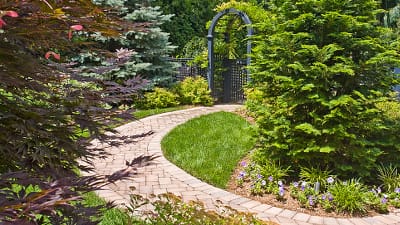 Spring is the perfect time of year to add to, or amend, your landscape design. A garden pathway provides the ideal way to add enchantment to your outdoor spaces, and to allow easy access for you and your guests to enjoy a perfectly positioned bench, or stroll amongst the seasonal foliage in the beautiful Northern New Jersey weather.
Spring is the perfect time of year to add to, or amend, your landscape design. A garden pathway provides the ideal way to add enchantment to your outdoor spaces, and to allow easy access for you and your guests to enjoy a perfectly positioned bench, or stroll amongst the seasonal foliage in the beautiful Northern New Jersey weather.
The most common materials used in garden walkways are gravel, pebbles and mulch. Here are some pros and cons of each to help you decide which is best for you and your ideal pathway for your garden.
Gravel Pathways
The most common type of gravel used for garden pathways is called pea gravel, which is made of crushed, rounded rock. The gravel pieces are about the size and shape of a pea, hence its name.
Using gravel in your garden walkway is great for those on a budget, and has several pros, including:
- You can choose from a variety of colors
- It adds a classic, timeless aesthetic
- Gravel pathways are long-lasting
- You can add to it easily every few years for a refreshed look
However, there are some cons to consider before choosing gravel:
- Over time, it can become dusty and untidy
- Your wheelbarrow and foot treads will leave depressions that will need to be raked smooth
- You will have to use a pathway border of some kind to keep gravel in place
- It can be hard on bare feet – the smaller the stones, the better if this is an issue
Pebble Pathways
In most cases, pebble garden pathways are used more for aesthetics, or an occasional stroll, because the larger stones are more unstable. However, they can be used to create lines to guide the eye towards a focal point such as a fountain or bird bath.
Some of the pros of using pebbles for your garden pathway include:
- They are beautiful to look at, and can be used to mimic a beach or a natural stream bed
- Color and pattern variations are endless
- Larger pebbles are durable and long lasting, so you won’t need to replace them or add to them very frequently
Like anything though, there are some cons to weigh before using pebbles:
- Pebbles can be more expensive, depending on the types of pebbles you choose
- They are harder to walk on with bare feet, and can be unstable for little ones and the elderly
- Rolling wheel barrows, or strollers, along pebbly paths is cumbersome
Mulch Pathways
A mulch walkway is the most natural option as it replicates a forest floor and can blend seamlessly with your garden and flower beds. Mulch creates a soft aesthetic.
If you’re interested in using mulch, here are some of the pros of using it in your garden pathway:
- Mulch is affordable
- Your landscape designer can incorporate mulch from your own garden waste
- It is organic and creates a soft, natural appearance
- Bare feet do well on mulch, as do wheelbarrows or strollers
- You can select the type of mulch materials you want based on appearance and texture
However, some of the cons of a mulch garden pathway include:
- You will need to use some type of border, where the path isn’t adjoined to beds, to keep it tidy
- It needs to be refreshed and replaced more often
- In moist environments, it is prone to mold/fungal growth
Conclusions
It’s hard to go wrong when choosing a material for a garden pathway. Whether you choose gravel, pebbles or mulch, each will bring a dynamic and appealing look to your walkways.
Consulting with an experienced landscape and design company can help you make the right choice for your home and garden. Telling them what your plans are for your pathway and how often it’ll be used will go a long way toward helping you achieve your dream walkway that can tie your outdoor living space together.

